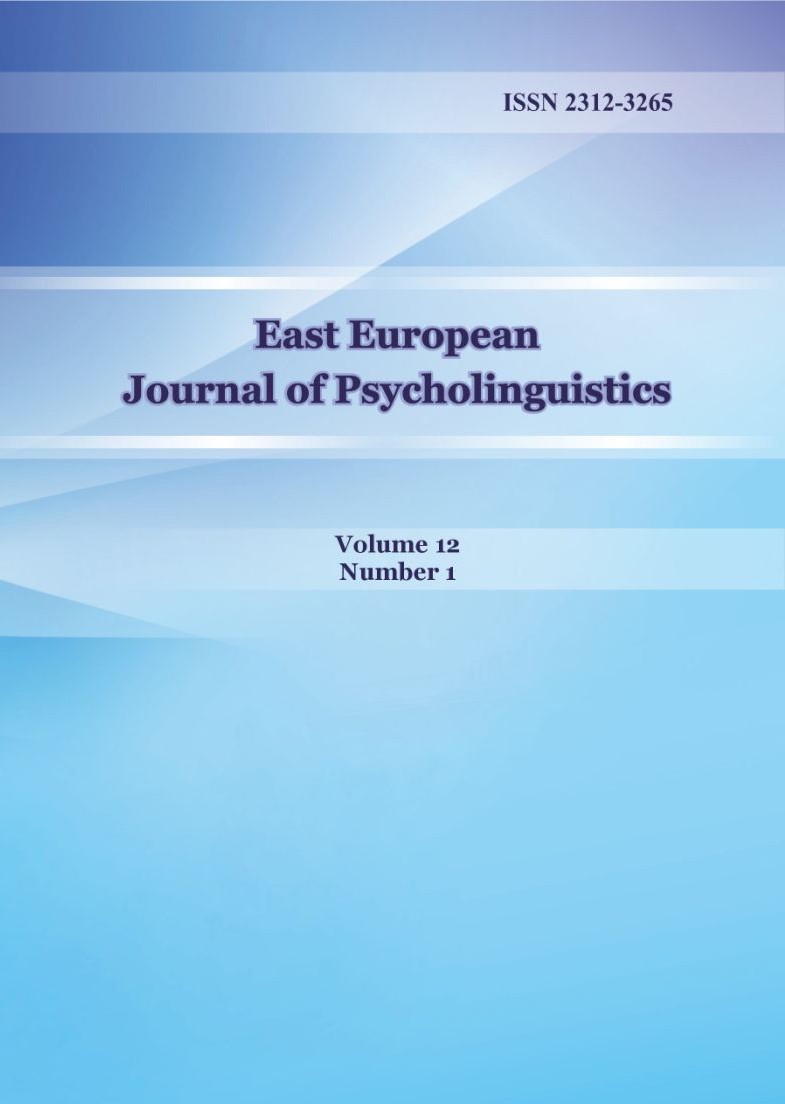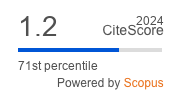Little words, big meaning – Ideational and pragmatic markers in fictional war discourse
DOI:
https://doi.org/10.29038/eejpl.2025.12.1.zasKeywords:
discourse markers, ideational markers, pragmatic markers, procedural meaning, LIWC, Bohdan Lepky, fictional war discourseAbstract
War discourse has gained importance amid today’s global instability due to war-related trauma. Because war often involves trauma, its fictional representation may disrupt language coherence. Discourse coherence, marked by specific linguistic cues, helps readers connect ideas. Without such markers, structure remains implicit, potentially hindering interpretation. From this perspective, ideational and pragmatic discourse markers − little linguistic items that structure and organise text − are vital. These connectives have “procedural meaning” (Blakemore, 2002), guiding readers towards comprehension with less cognitive effort. This article examines how such words function in fictional non-war and war discourse. Using the Ukrainian version of LIWC2015 and a Welch Two-Sample t-test in R, based on the specific weights of categories in the two sets of texts, it was possible to identify markers of trauma discourse in Bohdan Lepky’s wartime stories. The results showed that war fiction had a statistically significant reduction in both ideational and discourse-pragmatic markers of coherence. Additionally, there was a trend towards higher lexical density and the use of ‘tentative’ words, or ‘mitigation’ pragmatic markers, and ‘affect’ words, including indicators of anxiety with a focus on the present. These findings offer new insights into how discourse and other pragmatic markers shape the representation of traumatic experiences in the works of individual authors or fictional characters.
Acknowledgements
The author would like to acknowledge the support of the British Academy in funding this research.
Downloads
References
Alves F. & Gonçalves J. L. (2013). Investigating the conceptual-procedural distinction in the translation process. Target, 25(1), 107–124. https://doi.org/10.1075/target.25.1.09alv
Anthonissen, C. (2020). Autobiographical narrative of traumatic experience: Disruption and resilience in South African Truth Commission Testimonies. Applied Linguistics, 41(3), 370-388. https://doi.org/10.1093/applin/amaa010
Beaudreau, S. A., Storandt, M., & Strube, M. J. (2006). A comparison of narratives told by younger and older adults. Experimental Aging Research, 32, 105–117. http://dx.doi.org/10.1080/03610730500326481
Bifulco, A. (2021). Childhood Trauma in Women and Fragmented Interview Narratives – Some Interdisciplinary Methodological and Clinical Implications. East European Journal of Psycholinguistics, 8(1), 12–27. https://doi.org/10.29038/eejpl.2021.8.1.bif
Blacker, U. (2021). Memory, the City and the Legacy of World War II in East Central Europe. The Ghosts of Others. Routledge.
Blakemore, D. (2002). Relevance and Linguistic Meaning: The Semantics and Pragmatics of Discourse Markers. Cambridge University Press.
Brewin, C. R.(2025). Key concepts, methods, findings, and questions about traumatic memories. Journal of Traumatic Stress. https://doi.org/10.1002/jts.23164
Brewin, C. R., & Field, A. P. (2024). Meta-Analysis shows trauma memories in posttraumatic stress disorder lack coherence: A response to Taylor et al. (2022). Clinical Psychological Science, 12(5), 1027–1033. https://doi.org/10.1177/21677026241240456
Busch, B., & McNamara, T. (2020). Language and Trauma: An Introduction. Applied Linguistics, 41(3), 323–333. https://doi.org/10.1093/applin/amaa002
Caffi, C. (2013). Mitigation. In M. Sbisà and K. Turner (Eds.), Pragmatics of speech actions (pp. 257–285). De Gruyter Mouton.
Cobley, E. (1995). Postmodernist War Fiction: Findley’s The Wars. Canadian Literature, 147, 98–124. https://doi.org/10.29038/eejpl.2021.8.1.bif
Deppermann, A., & Lucius-Hoene, G. (2005). Trauma erzählen – kommunikative, sprachliche und stimmliche Verfahren der Darstellung traumatischer Erlebnisse. Psychotherapie und Sozialwissenschaft: Zeitschrift für Qualitative Forschung und klinische Praxis, 7(1), 35–73.
Eisler, D. F. (2022). Writing Wars: Authorship and American War Fiction, WWI to Present. University of Iowa Press. Retrieved from https://doi.org/10.2307/j.ctv2x00w38
Gibbs, R. W., Colston, H. L. (2020). Pragmatics always matters: An expanded vision of Experimental Pragmatics. Frontiers in Psychology, 11, 1619. https://doi.org/10.3389/fpsyg.2020.01619
Holmes, D., Alpers, G. W., Ismailji, T., Classen, C., Wales, T., Cheasty, V., Miller, A. & Koopman, C. (2007). Cognitive and emotional processing in narratives of women abused by intimate partners. Violence Against Women, 13, 1192–1205. https://doi.org/10.1177/1077801207307801
King, C. I., Romero, A. S. L., Schacter, D. L., & St. Jacques, P. L. (2022). The influence of shifting perspective on episodic and semantic details during autobiographical memory recall. Memory, 30(8), 942–954. https://doi.org/10.1080/09658211.2022.2061003
Kočote, I., & Smirnova, T. (2016). Aspects of military-related text translation from English into Latvian. Procedia – Social and Behavioral Sciences, 231, 107-113. https://doi.org/10.1016/j.sbspro.2016.09.078
Kusumitha, R. (2025). Ruptured minds, fractured verses: The psychodynamics of madness in war poetry. International Journal of Arts, Science and Humanities, 12(S4), 18-24. https://doi.org/10.34293/sijash.v12iS4.May.9146
Langacker, R.W. (2008). Cognitive grammar. A basic introduction. Oxford University Press.
Lenk, U. (1998). Discourse markers and global coherence in conversation, Journal of Pragmatics, 30(2), 245–257. https://doi.org/10.1016/S0378-2166(98)00027-7
Lepkyi, B. (1922). Poza mezhamy boliu. Nezabutni. Literaturni Narysy. Ukrains'ke slovo, 66–73.
Lu, Z., & Yuan, K. H. (2010). Welch's t-test. In N. J. Salkind (Ed.), SAGE Encyclopedia of Research Design (pp. 1620–1623). Sage Publishers.
Matei, M. (2013). The linguistic mechanisms of trauma discourse. Procedia – Social and Behavioral Sciences, 92, 517-522. https://doi.org/10.1016/j.sbspro.2013.08.711
Menne, F., Schäfer, S., Linz, N., Tröger, J., Schwed, L., Ettore, E., & König, A. (2025). Using speech analysis in virtual agent conversations to differentiate PTSD patients from control participants. Psychiatry Research, 348, 116486. https://doi.org/10.1016/j.psychres.2025.116486
Nicolle, S. (2007). The grammaticalisation of tense markers: A pragmatic reanalysis. In Tense, mood and aspect (pp. 47–65). Brill Rodopi.
Pasupathi, M. (2007). Telling and the remembered self: Linguistic differences in memories for previously disclosed and previously undisclosed events, Memory, 15, 3, 258–270. https://doi.org/10.1080/09658210701256456
Pennebaker J.W., Boyd R.L., Jordan K., & Blackburn K. (2015). The Development and Psychometric Properties of LIWC2015. University of Texas at Austin.
Pennebaker, J. W., & Seagal, J. D. (1999). Forming a story: The health benefits of narrative. Journal of Clinical Psychology, 55(10), 1243–1254. https://doi.org/10.1002/(sici)1097-4679(199910)55:10%3C1243::aid-jclp6%3E3.0.co;2-n
Pennebaker, J. W., & Stone, L. D. (2003). Words of wisdom: language use over the life span. Journal of Personality and Social Psychology, 85(2), 291–301. https://doi.org/10.1037/0022-3514.85.2.291
Redeker, G. (1990). Ideational and pragmatic markers of discourse structure. Journal of Pragmatics, 14(3), 367–381. https://doi.org/10.1016/0378-2166(90)90095-U
Ryan, R.A. (2023). Trauma and Linguistic Markers for Symptom Severity in Prolonged Exposure for Primary Care, as Observed Through the Use of Narrative Review. Unpublished PhD thesis. Melbourne, FL, USA.
Searle, J. R. (1975). The Logical Status of Fictional Discourse. New Literary History, 6(2), 319–332. https://doi.org/10.2307/468422
Sperber, D., & Wilson, D. (1995). Relevance: Communication and cognition (2nd ed.). Blackwell Publishing.
Taraban, R., Saraff, S., Zasiekin, S., Biswal, R. (2022). A psycholinguistic analysis of inter-ethnic views of ethics. East European Journal of Psycholinguistics, 9(1), 265–278. https://doi.org/10.29038/eejpl.2022.9.1.tar
Tausczik, Y. R., & Pennebaker, J. W. (2010). The psychological meaning of words: LIWC and computerised text analysis methods. Journal of Language and Social Psychology, 29(1), 24–54. https://doi.org/10.1177/0261927X09351676
van der Kolk, B. (2014). The Body Keeps the Score: Brain, Mind, and Body in the Healing of Trauma. Viking.
Wardell, V., Jameson, T., Bontkes, O. J. R., Le, M. L., Duan, T., St. Jacques, P. L., Madan, C. R., & Palombo, D. J. (2023). Fade in, fade out: Do shifts in visual perspective predict the consistency of real-world memories? Psychological Science, 34(8), 932-946. https://doi.org/10.1177/09567976231180588
Wilson, D. The conceptual-procedural distinction: Past, present and future. In V. Escandell-Vidal, M. Leonetti & A. Ahern (Eds.). Procedural Meaning: Problems and Perspectives (pp. 3–31). Emerald.
Zasiekin, S. (2016). Understanding translation universals. Babel, 62(1), 122-134. http://dx.doi.org/10.1075/babel.62.1.07zas
Zasiekin, S., Kuperman, V., Hlova, I., & Zasiekina, L. (2022). War stories in social media: Personal experience of Russia-Ukraine war. East European Journal of Psycholinguistics, 9(2), 160-170. https://doi.org/10.29038/eejpl.2022.9.2.zas
Zasiekin, S. (2024). Living through narratives: A psycholinguistic study of war stories by Bohdan Lepky and today’s Ukrainians in print and digital media. Digital Culture & Society, 10(1), 83-96. https://doi.org/10.14361/dcs-2024-0106
Zasiekin, S., Zasiekina, L. Altman, E., Hryntus, M. & Kuperman, V. (2025). The narratives of war (NoW) corpus of written testimonies of the Russia-Ukraine war. Language Resources and Evaluation, 59, 2415-2426. https://doi.org/10.1007/s10579-025-09813-8
Sources
Lepky, B. (2011). Vybrani Tvory [Selected Works]. In 2 Volumes. N. Bilyk & N. Havdyda, (Eds.). 2nd ed. Smoloskyp.
Lepky, B. (1905). Kara ta Inshi Opovidannia [Punishment and Other Stories]. Ukrainsko-Ruska Vydavnycha Spilka.
Lepky, B. (1975). Opovidannia [Story-book]. V. Lutsiv, Ed. State College, PA.
Downloads
Published
Issue
Section
License
Copyright (c) 2024 Serhii Zasiekin

This work is licensed under a Creative Commons Attribution 4.0 International License.











 Creative Commons «Attribution» 4.0
Creative Commons «Attribution» 4.0